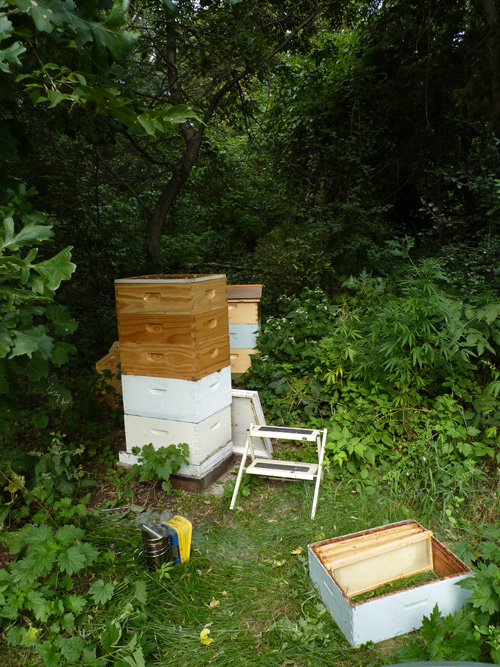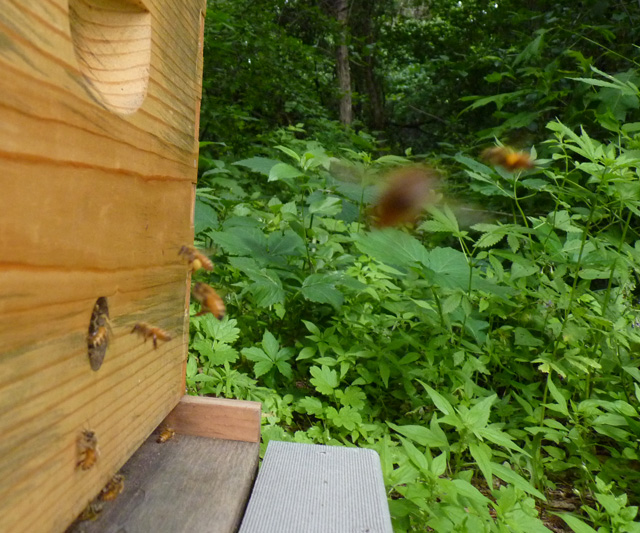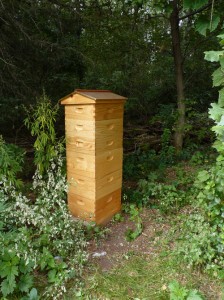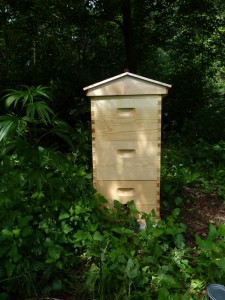Beltane Waxing Garlic Moon
Oh, boy. I’ve not gone a day without a post in a long time. Yesterday went by so fast.
Worked on Latin for a bit, but a brightening day pulled me outside. I plucked tulip detritus out of a bed where some tomato plants needed to go. These were full grown ones, liable to produce tomatoes as opposed to my healthy, but still immature seedling started back in April.
At the Minnesota Hobby Beekeepers meeting Tuesday I learned that honey filling what could be brood frames means the bees in colonies 2 and 3 felt crowded. I got out my honey supers, scraped them free of propolis, something I realized I could have done last fall, and excess wax, then plopped two each on 2 & 3. These are the colonies that will be allowed to die out over the winter. Colony 1 already has its 3rd hive box on with the queen producing brood at a quick pace. All three of these colonies started out on drawn comb which reduces the initial work load significantly and allows the bees to focus on brood raising, foraging and honey and pollen collecting.
All of this means Artemis hives have positioned themselves for the start of the honey flow.
Then it was quick get into my nicer clothes for a 3 hour stint at the Netroots Convention in downtown Minneapolis. I volunteered for service at the Sierra Club table in the convention’s exhibit hall. We highlighted our Beyond Coal campaign. I got into a snit with an organizer who felt that chairs should be anathema at tables. He feels this creates a climate that forces staff and volunteers out into the stream of traffic, pressing cards and information into people’s hands, getting names and addresses. At 64 standing on a concrete floor for 3 and 4 hours in a row is not something I choose to do. A chair gives me an opportunity to take a break now and then. Which I need.
The organizer’s view saw volunteers as numbers useful for gaining more numbers, rather than people. This is an instrumentalist view of the person, an error in judgment not unusual among utopians who willingly sacrifice today’s people in service of a better future. It ignores the true and only reason for organizing which is to gain a better life for others, a better life which begins in the present, not in some imagined or hoped for more powerful future.
Do we need to sacrifice to move our political ideas forward? Of course. Do we need to sacrifice our health and well-being? Only in extreme situations. Which the Netroots Convention in the Minneapolis Convention center is not.
After three hours of hawking underwear (I’ll explain later) and moving beyond coal as a source of electrical generation, I drove over to the Walker where I began a two session seminar at the Walker Art Center on THE BLURRING OF ART AND LIFE: IMPACT OF MASS CULTURE ON ART. Taught by an art historian from Hamline College, Roslye Ultan, this seminar approaches modern and contemporary art especially since Dada and Marcel DuChamp. There are ten or eleven of us in the class, all women save for me and all Walker guides save for me.
This means I find in myself cast in the unusual role of traditionalist. The MIA is an encyclopedic museum with an emphasis on the historicality and the geographicality of art from the earliest to the most recent, extending from a 20,000 year old Venus Figurine to a finished last year installation, Dreaming of St. Adorno by living artist, Siah Armajani.
Roslye takes her art historical cue from DuChamp who said he wanted to put art in the service of the mind. Rosalye has expanded on or extended this idea into an assertion that it is not the object that is the universal, transcendent work but the idea given form in the object. Seemingly entrenching my traditionalist orientation, I disagreed, holding out for the work of art itself as the what that transcended time.
She tried to tell me this was not right, but I am not easily budged by an argument from authority, so we had a tussle. A mild one. I backed off, as I often do in classroom settings, not wanting to waste other peoples time. In this instance, as the class progressed, I found the tussle invigorated the class, gave it an edge and increased my focus.
That was two instances of conflict in one day. On the drive home I turned them both over in my mind, like teasing a hole in a tooth. Was I too much in the argument with the organizer? Yes, my tone was over the top. Did I regret? Tone, yes. Content, no. I’ll apologize for the tone to him today. But not the need to treat volunteers as people not instruments.
The tussle in the class left me with no negative hangover. In fact, when I put the two together, I realized they meant I’m alive and still living. I felt good about that.
 amount of honey they would have needed for the winter, close to 200 pounds. Figure that 40 pounds is not recoverable due to drips, stuck on honey comb even after extraction then that should leave around 16o pounds to harvest.
amount of honey they would have needed for the winter, close to 200 pounds. Figure that 40 pounds is not recoverable due to drips, stuck on honey comb even after extraction then that should leave around 16o pounds to harvest.
 supers on over two hive boxes, the management practice for them will let them die off naturally at the end of the season. I’m looking forward to a better honey harvest than last year, but we’ll see. It’s still early days.
supers on over two hive boxes, the management practice for them will let them die off naturally at the end of the season. I’m looking forward to a better honey harvest than last year, but we’ll see. It’s still early days. frame from the box below to the new one to entice the bees up, eliminates swarming. No bee keeper wants a swarm because about half the bees and the young queen leave and the remaining, now queenless workers and nurse bees have to create an emergency queen. Since half of the workers are gone and emergency queens are not as productive as the new, young queen the beekeeper gets little if any surplus honey.
frame from the box below to the new one to entice the bees up, eliminates swarming. No bee keeper wants a swarm because about half the bees and the young queen leave and the remaining, now queenless workers and nurse bees have to create an emergency queen. Since half of the workers are gone and emergency queens are not as productive as the new, young queen the beekeeper gets little if any surplus honey. Lughnasa Waning Artemis Moon
Lughnasa Waning Artemis Moon